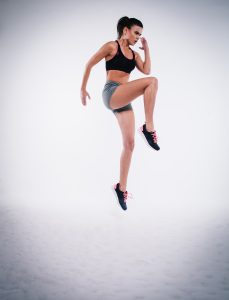The Warm Up – Let’s Stretch…Or Not
 Growing up, I always lived by the concept of ‘make sure you stretch before exercising, you don’t want to hurt yourself’. I’m sure we all agree that stretching has been a mainstay of the warm up routine for decades. Instinctively, it seems a good thing to do; it loosens up those muscles, feels good, and gets the body rarin’ to go. Or does it??
Growing up, I always lived by the concept of ‘make sure you stretch before exercising, you don’t want to hurt yourself’. I’m sure we all agree that stretching has been a mainstay of the warm up routine for decades. Instinctively, it seems a good thing to do; it loosens up those muscles, feels good, and gets the body rarin’ to go. Or does it??
The science is absolutely clear. Stretching DOES NOT prepare you to participate in exercise. It DOES NOT reduce injury. It DOES NOT enhance performance. In fact, the evidence is also piling up that static stretching reduces strength, power and explosiveness. WOW!
Why is this?
In order to get a better understanding let’s discuss what exactly is happening when you stretch. As a person sustains a static stretch of a muscle, what’s stretching? It’s what termed the ‘cytoskeleton’. That is, the covering of the active, elastic part of the muscle that does all the work. You are not stretching those small engine parts that are doing all the work. So, stretching does do 2 things:
- Increases the range of movement (by stretching the muscles covering)
- Has an analgesic effect (makes you feel good)
Are these good things?
 Certainly, feeling better is a positive effect. However, is increasing range of movement a positive effect? The short answer in most cases is, no! If you have the necessary range of movement to perform the skills of your sport or activity, then more range is not needed. In fact, creating more range can have a negative influence on performance. Why?
Certainly, feeling better is a positive effect. However, is increasing range of movement a positive effect? The short answer in most cases is, no! If you have the necessary range of movement to perform the skills of your sport or activity, then more range is not needed. In fact, creating more range can have a negative influence on performance. Why?
Let’s use distance runners as an example; distance running requires a very limited range of movement. The more flexible the runner is, the more energy that must first go into stabilizing the body before it can be used for propulsion.
Once again, the only reason for stretching prior to participating in exercise is the need for more range of movement. For gymnasts, this is important. For most sports and activities, it’s not necessary.
This does not mean that you shouldn’t warm up. Warming up is paramount!!! Warming up is crucial to preparing the body for increased physical demands. Warming up increases the thermal temperature of the muscle, helps lubricate the joints, and hones that mind-muscle connection so that when you ask your body to complete that intense task, the body is ready for it.
 Although the specifics of a proper warm up are not the intent of this blog, let’s review a few general rules of thumb:
Although the specifics of a proper warm up are not the intent of this blog, let’s review a few general rules of thumb:
- First, start your warm up with 10 minutes of aerobic based exercise (e.g., running, biking, etc.). This is to get the heart rate up, increase the thermal temperature of the muscle tissue, etc.
- Then, start to dynamically move the body through various of range of movements. This helps start to prepare the body for more intensive movements.
- Perform sport skills. Take your body through the various motions that you will be executing during your sporting activity. Perform this at a submaximal level starting around 50% intensity and eventually progressing to 80%. This prepares the body to perform your activity at full effort without the increased risk of injury.
When most of have only a certain amount of time to exercise and less to warm up, it’s crucial to do the proper things to reduce the likelihood of injury and to make the activity more enjoyable. Let’s take back that time we’re spending stretching and engage in those preparatory activities that really get us ‘rarin’ to go’.
References:
- Stark SD: Stretching techniques, in The Stark Reality of Stretching. Richmond, BC: Stark Reality Publishing, 1997, pp 73-80
- Newham DJ, McPhail G, Mills KR, et al: Ultrastructural changes after concentric and eccentric contractions of human muscle. J Neurol Sci 1983;61(1):109-122
- Hunter KD, Faulkner JA: Plyometric contraction-induced injury of mouse skeletal muscle: effect of initial length. J Appl Physiol 1997;82(1):278-283
- Markos PD: Ipsilateral and contralateral effects of proprioceptive neuromuscular facilitation techniques on hip motion and electromyographic activity. Phys Ther 1979;59(11):1366-1373
- Moore MA, Hutton RS: Electromyographic investigation of muscle stretching techniques. Med Sci Sports Exerc 1980;12(5):322-329
- Magnusson SP, Simonsen EB, Aagaard P, et al: Mechanical and physical responses to stretching with and without preisometric contraction in human skeletal muscle. Arch Phys Med Rehabil 1996;77(4):373-378
- Gergley JC: Acute effect of passive static stretching on lower-body strength in moderately trained men. J Strength Cond Res. 2013 Apr;27(4):973-7
- Simic L1, Sarabon N, Markovic G: Does pre-exercise static stretching inhibit maximal muscular performance? A meta-analytical review. Scand J Med Sci Sports. 2013 Mar;23(2):131-48
